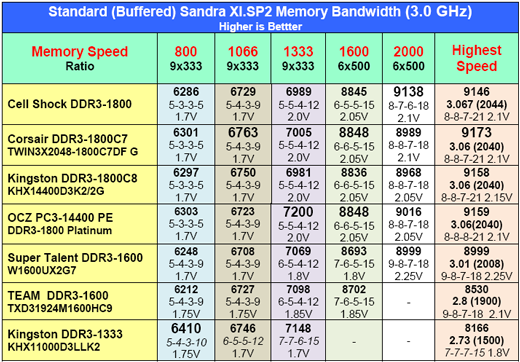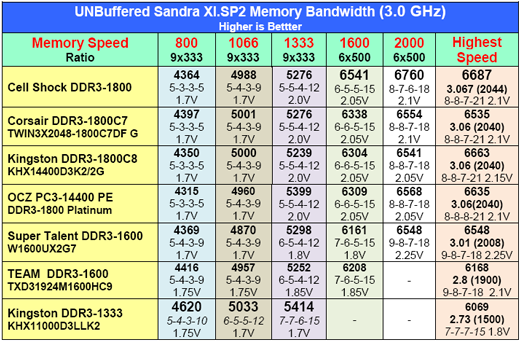Cell Shock, Corsair, and Kingston Introduce Ultra Speed DDR3
by Wesley Fink on October 11, 2007 10:00 PM EST- Posted in
- Memory
Bandwidth and Memory Scaling
As you saw in the overclocking graph on the previous page, all five of the memories based on Micron Z9 memory chips reached a stable overclock of more than 2000MHz. This remarkable overclock should translate into higher bandwidth with DDR3 at higher speeds.
To better understand memory performance at speeds from DDR3-800 to DDR3-2000+ we compared Standard or Buffered bandwidth of the Cell Shock DDR3-1800, Corsair DDR3-2800C7, and Kingston DDR3-1800C7 at all tested speeds. The processor in each case is running 3.0 GHz as detailed in the Memory Test Configuration on page three. The bandwidths of the three new memories tested in this review were then compared to all DDR3 memory we have tested to date.
At DDR3-800 the Elpida LL based Kingston is the best performer in the standard Sandra bandwidth test. However, at 1066 the lead now shifts to the Corsair 1800, OCZ DDR3-1800 at 1300, Corsair at 1600, Cell Shock at 2000, and the Corsair again at the highest speed. The Micron Z9-based memories now own the bandwidth records at 1066 to the highest speed that can be reached, which is 2044MHz. There is no clear winner among the five Micron memories, with a very tight clustering of results across the test results.
We also test memory with buffering schemes like MMX, SSE, SSE2, SSE3, etc, turned off. While these features do provide apparent improved bandwidth, the Unbuffered bandwidth tends to correlate better with real-world application performance. Unbuffered performance does not always follow the same pattern of buffered memory performance.
The unbuffered results are very interesting, and the memory bandwidth does not really behave the same as the standard buffered test results. There are really two standout memories in this test. The low-latency Elpida-based Kingston DDR3-1333 is top performer at 800, 1066, and 1333. When speed is cranked up to the upper DDR3 speeds, however, the winner is Cell Shock - which tops Unbuffered test results at 1600, 2000, and the highest speed of 2044. Cell Shock appears to have paid careful attention to the types of memory performance that matter most to enthusiasts, which is likely why the new brand has been so well received at enthusiast sites.
This should not be misconstrued, however. Once again the test results from all five Micron based memory kits are very close, and nothing really stood out among this group. The Super Talent was the first Micron Z9 out of the gate, and as such it did not have the benefit of other manufacturers' experiences to help in final binning and programming the SPD. A retest of a more recent Super Talent memory kit will likely show Super Talent has undergone some tweaks with the performance now neck and neck with the other recent Micron entries.
As you saw in the overclocking graph on the previous page, all five of the memories based on Micron Z9 memory chips reached a stable overclock of more than 2000MHz. This remarkable overclock should translate into higher bandwidth with DDR3 at higher speeds.
To better understand memory performance at speeds from DDR3-800 to DDR3-2000+ we compared Standard or Buffered bandwidth of the Cell Shock DDR3-1800, Corsair DDR3-2800C7, and Kingston DDR3-1800C7 at all tested speeds. The processor in each case is running 3.0 GHz as detailed in the Memory Test Configuration on page three. The bandwidths of the three new memories tested in this review were then compared to all DDR3 memory we have tested to date.
 |
| Click chart to enlarge |
At DDR3-800 the Elpida LL based Kingston is the best performer in the standard Sandra bandwidth test. However, at 1066 the lead now shifts to the Corsair 1800, OCZ DDR3-1800 at 1300, Corsair at 1600, Cell Shock at 2000, and the Corsair again at the highest speed. The Micron Z9-based memories now own the bandwidth records at 1066 to the highest speed that can be reached, which is 2044MHz. There is no clear winner among the five Micron memories, with a very tight clustering of results across the test results.
We also test memory with buffering schemes like MMX, SSE, SSE2, SSE3, etc, turned off. While these features do provide apparent improved bandwidth, the Unbuffered bandwidth tends to correlate better with real-world application performance. Unbuffered performance does not always follow the same pattern of buffered memory performance.
 |
| Click chart to enlarge |
The unbuffered results are very interesting, and the memory bandwidth does not really behave the same as the standard buffered test results. There are really two standout memories in this test. The low-latency Elpida-based Kingston DDR3-1333 is top performer at 800, 1066, and 1333. When speed is cranked up to the upper DDR3 speeds, however, the winner is Cell Shock - which tops Unbuffered test results at 1600, 2000, and the highest speed of 2044. Cell Shock appears to have paid careful attention to the types of memory performance that matter most to enthusiasts, which is likely why the new brand has been so well received at enthusiast sites.
This should not be misconstrued, however. Once again the test results from all five Micron based memory kits are very close, and nothing really stood out among this group. The Super Talent was the first Micron Z9 out of the gate, and as such it did not have the benefit of other manufacturers' experiences to help in final binning and programming the SPD. A retest of a more recent Super Talent memory kit will likely show Super Talent has undergone some tweaks with the performance now neck and neck with the other recent Micron entries.










12 Comments
View All Comments
Wesley Fink - Friday, October 12, 2007 - link
At the top of the pricing info is the name of the item being priced. In this case the engine is likely picking up Compact Flash prices at camera companies in the same memory size. The larger concern is that the pricing engine does not recognize Cell Shock right now in the pointer. Work is being done to expand the database.The Price Engine often does not pick up new items just introduced, but it is dynamic. If you look back in a few weeks the pricing info will be revised even though the pointer is the same and it will likely find the original described product.
yyrkoon - Friday, October 12, 2007 - link
And what prices are youtalking about exactly ? That is definately not DDR3 memory pricing . . .